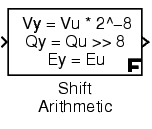

| Fixed-Point Blockset |   |
Shift the bits and/or radix point of a signal
Library
Description
The Shift Arithmetic block can be used to shift the bits or the radix point of a signal, or both.
For example, the effects of radix point shifts two places to the right and two places to the left on an input of data type sfix(8) are shown below.
| Shift Operation |
Binary Value |
Decimal Value |
| No shift (original number) |
11001.011 |
-6.625 |
| Radix point shift right by 2 places |
1100101.1 |
-26.5 |
| Radix point shift left by 2 places |
110.01011 |
-1.65625 |
This block performs arithmetic bit shifts on signed numbers. Therefore, the most significant bit is recycled for each bit shift. The effects of bit shifts two places to the right and two places to the left on an input of data type sfix(8) follow.
| Shift Operation |
Binary Value |
Decimal Value |
| No shift (original number) |
11001.011 |
-6.625 |
| Bit shift right by 2 places |
11110.010 |
-1.75 |
| Bit shift left by 2 places |
00101.100 |
5.5 |
Parameters and Dialog Box
Characteristics
 | Scaling Strip | Sign |  |